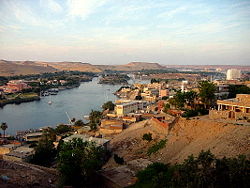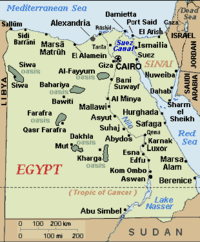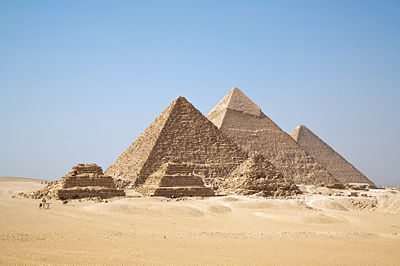Aswan
| Aswan أسوان |
|
 |
|
 |
|
| Coordinates: | |
| Government | |
| - Governor | Samir Youssef |
|---|---|
| Population | |
| - Total | 200,000 |
| Time zone | EET (UTC+2) |
| - Summer (DST) | EEST (UTC+3) |
Aswan (formerly spelled Assuan), (in standard Arabic: أسوان Aswān) Egyptian: Swenet (trade), Coptic: ⲥⲟⲩⲁⲛ Swān; Greek: Συήνη Syene; Spanish: Asuán) is a city in the south of Egypt, the capital of the Aswan Governorate.
It stands on the east bank of the Nile at the first cataract and is a busy market and tourist center. Its ancient name, Swenet, translates as "trade". It contains the island of Elephantine.
Aswan is one of the driest inhabited places in the world; as of early 2001, the last rain there was six years earlier. As of 8 September 2008[update], the last rainfall was a thunderstorm on May 13 2006. In Nubian settlements, they generally do not bother to roof all of the rooms in their houses.
Contents |
History
| swn.t in hieroglyphs |
||||
|---|---|---|---|---|
|
Aswan is the ancient city of Swenet, which in antiquity was the frontier town of Ancient Egypt to the south. Swenet is supposed to have derived its name from an Egyptian goddess with the same name. This goddess later was identified as Eileithyia by the Greeks and Lucina by the Romans during their occupation of Ancient Egypt because of the similar association of their goddesses with childbirth, and of which the import is "the opener". The ancient name of the city also is said to be derived from the Egyptian symbol for trade.[1]
Because the Ancient Egyptians oriented toward the origin of the life-giving waters of the Nile in the south, Swenet was the first town in the country, and Egypt always was conceived to "open" or begin at Swenet. The city stood upon a peninsula on the right (east) bank of the Nile, immediately below (north of) the first cataract of the flowing waters, which extend to it from Philae. Navigation to the delta was possible from this location without encountering a barrier.
The Stone quarries of ancient Egypt located here were celebrated for their stone, and especially for the granitic rock called Syenite. They furnished the colossal statues, obelisks, and monolithal shrines that are found throughout Egypt, including the pyramids; and the traces of the quarrymen who wrought in these 3000 years ago are still visible in the native rock. They lie on either bank of the Nile, and a road, four miles in length, was cut beside them from Syene to Philae.
Swenet was as equally important as a military station as that of a place of traffic. Under every dynasty it was a garrison town; and here were levied toll and custom on all boats passing southward and northward. The city is mentioned by numerous ancient writers, including Herodotus (ii. 30), Strabo (ii. p. 133, xvii. p. 797, seq.), Stephanus of Byzantium (s. v.), Ptolemy (vii. 5. § 15, viii. 15. § 15), Pliny the Elder (ii. 73. s. 75, v. 10. s. 11, vi. 29. s. 34), De architectura (book viii. ch ii. § 6), and it appears on the Antonine Itinerary (p. 164). It also is mentioned in the Book of Isaiah from the Scriptures (ref. Isaiah 49:12).

The latitude of the city that would become Aswan, located at – 24° 5′ 23″– was an object of great interest to the ancient geographers. They believed that it was seated immediately under the tropic, and that on the day of the summer solstice a vertical staff cast no shadow. They noted that the sun's disc was reflected in a well at noon. This statement is only approximately correct; the ancients were not acquainted with the exact tropic: yet at the summer-solstice the length of the shadow, or 1/400th of the staff, could scarcely be discerned, and the northern limb of the sun's disc would be nearly vertical.
Eratosthenes used measurements at Aswan (Elephantine) to contest the Flat Earth theory and attempted to determine the circumference of the Earth, using Syene (as the Greeks called Swenet) as the originating point and Alexandria as the terminal point of a measured arc (based upon shadow length at the solstice) to make an accurate estimate of the circumference of the Earth.
The Nile is nearly 3000 yards wide above Aswan. From this frontier town to the northern extremity of Egypt the river flows for more than 750 miles without bar or cataract. The voyage from Aswan to Alexandria usually occupied between 21 and 28 days in favourable weather.
Education
South Valley University is located in Aswan. It has two faculties of engineering named as Faculty of Engineering and Technology and Faculty of Engineering and Energy. It has also a faculty of science and faculties of humanities.
Gallery
See also
- Abu Simbel
- Aswan Dam
- Elephantine
- Philae
- Luxor
- Kitchener's Island
- Temple of Kalabsha
References
- This article incorporates text from the public domain Dictionary of Greek and Roman Geography by William Smith (1856).
- ↑ Suʻād Māhir (1966). Muhafazat Al Gumhuriya Al Arabiya Al Mutaheda wa Asaraha al baqiah fi al asr al islami. Majlis al-Aʻlá lil-Shuʼūn al-Islāmīyah. http://books.google.com/books?id=jEL5GwAACAAJ.
External links
|
|||||
|
|||||||
![S29 [s] s](/2009-wikipedia_en_wp1-0.7_2009-05/I/hiero_S29.png)

![N35 [n] n](/2009-wikipedia_en_wp1-0.7_2009-05/I/hiero_N35.png)
![X1 [t] t](/2009-wikipedia_en_wp1-0.7_2009-05/I/hiero_X1.png)
![O49 [niwt] niwt](/2009-wikipedia_en_wp1-0.7_2009-05/I/hiero_O49.png)
